Abstract
The 2019 coronavirus disease (COVID-19) global pandemic spread can be considered a disastrous crisis that, in a given geographical area, significantly affects the increase in mortality rate with direct and indirect impacts on different scales and social, economic, political, and ecological factors. The effects of this crisis can be more intense in urban areas with high population density. Due to the more significant presence of vulnerable groups, the risk of death increases significantly. This research describes the environmental impacts of the COVID-19 pandemic in the city of Tehran, the 37th most populated city in the world. The concentration of six air pollutants (carbon monoxide (CO), ozone (O3), nitrogen dioxide (NO2), particulate matter with a diameter of 10 microns (PM10), sulfur dioxide (SO2), particulate matter with a diameter of fewer than 2.5 microns (PM2.5) and the Air Quality Index (AQI) were measured in 22 urban regions of Tehran before (20 March) and from (21 March to 10 February) the lockdown, in air pollution evaluation stations. In order to conduct this research, first, the values of the air pollutant indices of the 22 districts of Tehran in the two previous periods (before 20 March) and during quarantine (21 March to 10 February) were obtained from the air pollution measurement stations of the 22 districts of Tehran, together with the results. After the operationalization and quantification of the indicators according to the research objectives, they were entered into the ArcGIS environment, and the spatial analysis of each pollutant was performed, before and during the quarantine. Finally, it was found that the AQI was reduced from 74.95 to 54.15.
1. Introduction
The earth is a dynamically changing planet shaped by socio-environmental interactions. These changes are regular in a dynamic and nonlinear system such as planet earth [1,2,3,4]. Meanwhile, increasing changes in natural processes are often caused by human interventions, which bring risks that may lead to human disasters and disturb environmental sustainability of the environment [5,6]. Among these, the COVID-19 pandemic is considered a disastrous crisis that can lead to significantly increased mortality and disruptions in various geographical regions’ economic, political, social, and human systems on multiple scales [7,8]. This acute respiratory syndrome was caused by a viral agent (SARS-CoV-2) in late December 2019 near a seafood market in Wuhan, the capital of Hubei Province, China [9,10,11,12,13], and the disease was named COVID-19 on 12 January 2020, by the World Health Organization [9]. Several authors hypothesized that the disease spread rapidly due to different environmental conditions [14,15,16]. In particular, living in an area with high levels of pollutants can make a person susceptible to chronic respiratory diseases and, therefore, suitable for infectious agents such as SARS-CoV-2 [17,18,19].
In this regard, in addition to health issues and economic recession, many thinkers and experts in the field of global sustainability believe that COVID-19 disease is a clear sign of instability in the worldwide system, it shows how vulnerable and unequal human societies are to catastrophic disasters, and how we are not prepared to deal with global catastrophes [20]. The COVID-19 crisis tests human resilience to the uncertain future because societies face severe climate change, degraded ecosystems, and biodiversity loss [21]. Thus, according to Duflot et al. (2021), COVID-19 is a new environmental crisis causing societies to become unstable and fragile. Therefore, to build sustainable and resilient societies, communities must be prepared to deal with such significant threats to humanity, taking the example of the COVID-19 crisis [22,23]. Several measures have been taken by all involved countries to prevent the further spread of COVID-19 and to reduce the mortality rate, such as social distancing, lockdowns, curfews, and border closures. Most of the governments temporarily closed public places to minimize the spread of COVID-19 [24]. Although their application, intensity, and efficiency vary in different countries [25], these decisions caused dramatic changes in the behavior of millions of people in a short time [20]. As a result of these necessary measures, many daily activities, such as personal vehicle use, public transportation, and industrial activities, were affected by lockdowns [26,27,28,29]. These shutdowns severely affected the industrial and manufacturing sectors [30], global oil demand declined sharply, and the environment was the only one to benefit from the limited socio-economic activities [9,30,31]. Thus, contaminants such as greenhouse gases, black carbon, nitrogen dioxide, and water pollution declined across various regions of the world [32,33,34,35,36,37]. For instance, during the lockdown periods, air pollution in Barcelona decreased by 50% [34]; China’s carbon emission dropped by 25% (one million tons) [34]; the particulate matter (PM2.5) emission decreased by about 58.4% in Malaysia. In Italy, the water pollution level of the Grand Canal in Venice decreased [31]; and India’s surface water quality improved significantly due to the 15.9% decrease in small particulates matter [38]. Such a condition has been observed at various scales worldwide in multiple regions, such as Iran, where the lockdowns have led to the increased water quality of the Caspian Sea and has reduced ecological resource destruction in jungles. The positive effects of the pandemic on the environment can serve as a solid incentive to guide policymakers toward building sustainable and resilient communities [30] by transforming the COVID-19 experience into a comprehensive approach to improving human relations with the environment, and providing the basis for achieving sustainable development goals [39].
Despite the importance of the resulting improvements in temporarily reducing greenhouse gas emissions, improving air quality during lockdown [40,41,42], reducing water pollution [43], and reducing environmental noise [34], we could also observe adverse effects, such as increasing the production of non-recyclable waste that endangers environmental sustainability [44,45]. Thus, the positive environmental effects observed are primarily short-lived and may reappear over time as lockdown effects decrease. Indeed, recent data show that global greenhouse gas companies are now resuming their activities more vigorously after the hiatus (https://www.iea.org/articles/global-energy%20review (accessed on 12 November 2020)). In recent months, scientific and political debates [46,47] regarding the COVID-19 pandemic experience and climate change management are still heated, and suggest a possible transition to building environmentally sustainable communities.
The coexistence of energy, economy, and environment is a prerequisite that ensures healthy, stable, and sustainable development [48]. The importance of paying attention to human health and environmental sustainability can be seen as one of the goals of sustainable development following the spread of the COVID-19 pandemic. Consequently, adding human health as a fourth pillar to the broad definition of sustainability is a logical step toward achieving a sustainable society [49].
The primary hypothesis of this research is that the COVID-19 pandemic can be considered a transition framework toward building communities marked by the environmental sustainability principles of socio-technological resilience [50,51].
In this regard, according to the purpose and nature of the research, three specific questions are raised: (1) How does the pandemic of COVID-19 affect the progress of transitions toward environmental sustainability? (2) What are the structural similarities between COVID-19 and environmental crises (for example, climate crises)? (3) How does the transition to environmental sustainability affect the future air quality of metropolitan areas?
Therefore, to address the above questions, in the present study we intend to improve the quality of the biosphere and air by examining how changes in people’s lifestyles can help, as well as policies that have been adopted to combat the spread of the virus, thereby providing a framework for better understanding the effects of COVID-19 disease on the environmental sustainability of the Tehran metropolis.
2. Materials and Methods
Achieving sustainability requires a shift in worldview from the technological city of modernism [52] to an understanding of humanity’s dependence on ecosystems that leads to a reconnection with nature [53]. To achieve this goal, policy choices must be made with clear criteria.
The social changes induced by the spread of the COVID-19 pandemic have drastically changed our routines with effects (which may be long-term) regarding the reduction of vehicular traffic and air pollution. This has led to further digital and telecommunication developments and, assuming that a percentage of smart-working will remain active even after the emergency phase of the pandemic, there will be those urban spaces that will remain vacant because they are not needed (such as areas for parking, locations for new infrastructure, areas for new buildings, and more). Post-epidemic design and planning strategies should reflect these changes. For example, building sustainable and resilient communities could be leveraged and reclaimed for green space, bike lanes, pedestrian paths, and more [54,55]. This article is practical in terms of purpose, and descriptive-analytical in terms of the research method. For this research on coronavirus and environmental effects with emphasis on air quality (Iran-Tehran), first of all, the values of 6 pollutant elements CO, O3, NO2, PM10, SO2, PM2.5 in 22 districts of Tehran, in two periods (before and during the quarantine) were received from the relative air pollution measurement stations. Then, operationalization and quantification of the pollutants were carried out according to the research objectives in the ArcGIS environment. In order to evaluate the variation in the state of pollutant elements during and before the quarantine, their spatial arrangement and a specific indicator at the regional level were carried out. The research results were presented in charts and maps and are discussed in the last paragraph.
2.1. COVID-19 in Tehran
Tehran, the capital of Iran, is located 35°34′ and 35°51′ north latitude and 51°6′ to 51°38′ east. Its altitude varies from sea level between 1800 m in the north to 1200 m in the middle to 1050 m in the south (Figure 1). Tehran has a 730 km2 total area [56]. The Middle East’s largest metropolis, Tehran, is now ranked 16th among the most densely populated cities on the planet. According to the most recent Iranian population and housing census, it has a population of 8,693,706 inhabitants. There are 22 districts in Tehran [51,56,57,58].
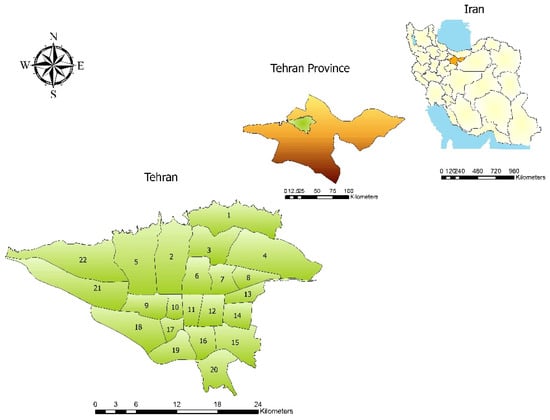
Figure 1.
The geographical location of Tehran in Iran. Drawing authors, 2022.
When Tehran was designated as the capital in 1785, there were barely 15,000 people living there. Figure 2 depicts Tehran’s urbanization trend over a 115-year interval. Its population increased 400 times between the 1780s and the 2019s, from 15,000 to 8,693,706, which has a tangible impact on sustainable urban growth [59].
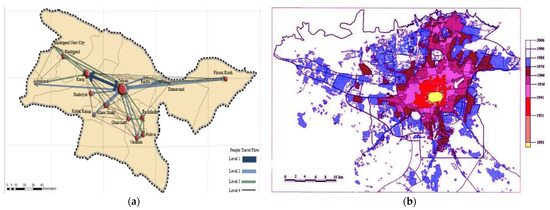
Figure 2.
(a) The influential currents in the spatial structure of the Tehran metropolis. (b) The growth of Tehran. Drawing authors, 2022.
The virus spread quickly across the country and infected 1365 people by 12 March 2020, in less than 20 days, to the point that Iran had the highest number of infected patients after China. So far (October 2022), 7.55 million people have been infected with this deadly virus in Iran, among which 145,000 people have died. In the first days of the coronavirus spread, the increasing trend led the government authorities to adopt strategies to fight against this unknown virus. However, Iran initially adopted the strategy of taking medical measures, similar to many other North American and European countries. Still, it was revealed in March that this strategy could no longer respond to the problems due to the spread of the virus. At this time, along with the first peek of COVID-19 in the country, the government announced a three-level nationwide lockdown from 21 March 2020, until 10 April 2020.
With the first lockdown, all human activities, including construction, industry, and tourism, were suspended, urban and cross-city movements and other public transport activities were limited; religious, educational, and market centers were closed, etc. As a result, industrial and human activities decreased significantly, and all rural and urban contexts were transformed into empty settlements without the smog and vehicular traffic. These measures taken by the government led to a significant improvement in urban environment quality and human health, particularly in Tehran, a result that became much more tangible with the second to fourth peaks of the disease, and the subsequent lockdowns.
2.2. Pollutants Concentration and AQI Level
Aiming to answer the current research questions, the concentration of seven air pollutants was measured in the 22 urban regions of Tehran before and during the lockdown period. The data came from air pollution measurement stations in the 22 metropolitan areas in Tehran. The indicators were then quantified and operationalized in the ArcGIS environment. After the studied indicators were quantified, the location organization of the spatial patterns in the regions was determined as a unit set to evaluate the changes in the pollutants using accurate metric spatial maps of Tehran and based on the spatial structure data of the city. The changes in air pollutants before and during the quarantine were presented in maps and Charts. The pollutants examined in the present study include CO, O3, NO2, PM10, SO2, PM2.5, and AQI.
Among the particulate matter (PM) in the air, PM10 and PM2.5 are highly dangerous air pollutants [60]. These particles are small enough to easily pass through the lungs and enter the bloodstream [61]. NO2 is a toxic gas emitted from factories and vehicle exhausts. The World Health Organization has declared that concentrations over 200 ppb of this gas can physiologically result in inflammation in the respiratory path and eventually lead to asthma [62]. O3 is a gas found both in the stratosphere and the troposphere. Troposphere O3 is considered an important greenhouse gas and plays a significant part in climate change [63].
SO2 is the oxide with the highest emission content in the atmosphere. Sulfur dioxide is a clear and non-combustible gas with a burning and unpleasant odor at concentrations around three ppm.
CO is a clear, tasteless, and odorless gas resulting from the incomplete combustion of fossil fuels and coal. Carbon monoxide concentration depends on urban regions’ traffic situation and weather changes. Over 70% of the carbon monoxide emitted is due to the movement of automobiles and transportation [61]. AQI is a dimensionless index used to announce and predict the daily air quality calculated by the American Environment Protection Association in Iran [64,65]. Six primary air pollutants, including carbon monoxide, nitrogen dioxide, ozone, sulfur dioxide, particulate matter smaller than 10 microns, and particulate matter smaller than 2.5 microns, are generally used to calculate this index. According to the National Air Quality Index (NAQI), the average time for the pollutants of PM2.5, PM10, NO2, SO2, Pb, and NH3 is 24 h, while O3 and CO have a 1 h average [66].
In Equation (1), IAQIp is a sub-indicator of air quality with the pollutant P. CP represents the mass of the P pollutant. BPHI is the upper limit of the pollutant concentration close to CP. MPLo indicates the lower limit of the pollutant concentration near CP. IAQIHi represents the sub-index of air quality regarding BPHi, and IAQILo is the air quality sub-index corresponding to BPLo [11]. This index was calculated in March 2020 based on the breaking points proposed by the American Environment Protection Association. According to the breaking points table, the pollutants with the highest figures in the air quality index are considered the primary pollutant when AQI is above 50. Those with IAQI larger than 100 are considered pollutants with high standards than acceptable limits.
3. Principal Research Observations
Air pollution is, at present, one of the main problems for public health, according to reports from the World Health Organization (WHO) [67,68]. For the past two decades, Tehran has witnessed fast industrial growth and increased transportation felt in many routes as the elite management center of the country, which has improved people’s quality of life [69]. However, heavy air pollution has paid the price for this development. Global statistics suggest that Tehran is the 7th most polluted city globally, following Jakarta, the capital of Indonesia [70]. The migration trends to Tehran, economic activity growth, and personal vehicle overuse have also contributed to this problem. According to the University of Tehran and Iran’s Ministry of Health report, in 2019, an annual population of around 45,000 died due to PM2.5. This figure amounted to 10% (33 million cases) of the total mortality cases in the country in 2019, among which 3000 cases were from Tehran. However, the noteworthy point is that air pollution in Tehran has decreased over the past decade and has declined the most during 2020 and 2021, along with the spread of COVID-19. Chart 1 demonstrates Tehran’s air pollutants concentration over the past decade (2011–2021) (Figure 3).
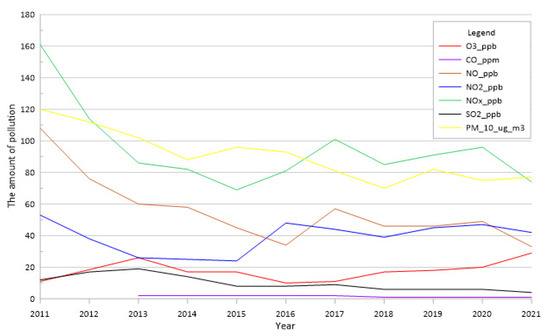
Chart 1.
The concentration of air pollutants in Tehran over the past decade.
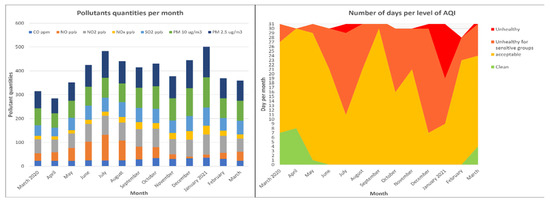
Figure 3.
The concentration of pollutants from March 2020 to March 2021 in Tehran.
3.1. Pollutants Concentration and AQI Level during the COVID-19 Outbreak
Considering those above, a general comparison between the primary air pollutants in the wake of the coronavirus crisis and the first nationwide 20-day lockdown indicates that many air pollutants declined significantly on the last day of the lockdown (10 April 2020) compared to 20 March 2020, including PM2.5 (30 micrograms), PM10 (25 micrograms), SO (6 micrograms), NO2 (27 micrograms), O3 (2 micrograms), and CO (9 micrograms) These differences are shown in Table 1.

Table 1.
Differences in pollutants concentration and AQI index before and during the lockdown of 20 March 2020.
Particulate matter in the air, including PM2.5 and PM10, are among the most dangerous air pollutant. These two carcinogens have always been considered among Group-I carcinogens by the World Health Organization [61]. These particles are so small that they can easily pass through the lungs and be released into the bloodstream, resulting in respiratory problems, heart attacks, and premature death. The World Health Organization (WHO) has estimated that over four million people die annually worldwide due to heart diseases, stroke, lung cancer, chronic lung diseases, and respiratory infections due to PM2.5 and PM10 exposure [71]. Such issues are more acute in the pollutant cities of the world, such as Tehran [68]. After COVID-19 spread, more human activities, including personal activities, industrial infrastructures, and traffic, decreased. As a result, in 2020 and 2021, PM2.5 and PM10 particles, which primarily consisted of dust from motor vehicle traffic, industrial processes, combustion, fuel use in residential buildings, cooking, and secondary reactions, decreased dramatically.
After the spread of the coronavirus in Tehran (late January 2020), the decline in social interaction and traffic in crowded areas resulted in public transportation and road traffic declining by 34.5% and 7.2% in Tehran, respectively. Thus, according to Chart 1 and Tehran air quality reports [72], this suggests that the average annual PM2.5 and PM10 concentrations that have been persistently declining since 2016 underwent a sharp decrease in the middle of February 2020, and with the critical spread of the COVID-19, the implementation of two-week travel restrictions and the change in lifestyle resulted in improved air quality across all the urban regions. The condition of PM2.5 and PM10 pollutants will be more closely examined.
3.2. PM2.5 Concentration before and during the Lockdown of 20 March 2020
Table 2 demonstrates the average PM2.5 attention from March 2020 to April 2021, along with the three-level quarantine in Tehran. This pollutant, which represents a broad spectrum of tiny particles with various sizes and diameters smaller than 2.5 microns, is mainly the result of combustion reactions, particularly in motor vehicles such as diesel cars, the friction resulting from the movement of vehicles, and the interaction of other pollutants in the air which produces PM2.5 particles as secondary pollutants. This pollutant will accumulate in the air for several days in the case of stable weather conditions or dust, and is considered the primary air pollutant in Tehran on almost all polluted days. However, it can be observed from Table 2 that the spread of COVID-19 and the preventive measures taken by the Iranian government, which resulted in traffic restrictions and house lockdowns from 20 March to 10 April, resulted in a decrease in this pollutant’s concentration; the lowest PM2.5 concentrations have been recorded over this period compared to the other months of the year.

Table 2.
Average monthly concentration of pollutants over March 2020–April 2021.
The average monthly concentration of PM2.5 indicates that the lowest concentrations of this pollutant were recorded in April and March. As shown, the highest monthly averages are mainly observed in the year’s cold months due to the low temperature, increased atmosphere stability, and air inversion, which results in the accumulation of pollutants in the air. The highest pollutant concentration in 2021 has also been recorded in December, demonstrating that this month has been significantly unhealthier in terms of air quality than other months of the year.
Chart 2 shows the annual PM2.5 average concentration resulting from sampling from various stations in the 22 urban regions of Tehran during the quarantine. As observed, the condition of the pollutant is unfavorable in all stations compared to the annual standard of Iran (the red line at 12 ) over 2020, despite its relative improvement in terms of daily measures. No similar trend is observed for all the regions before and after the three-level quarantine announced on 20 March. According to Table 1, region 16 marks the lowest concentration of PM2.5 at the beginning of the quarantine with a concentration of 26 region 13 has the highest concentration of 64.68 . However, a significant decrease in PM2.5 can be observed in all the regions and stations at the start of the quarantine, compared to the period before it. The highest PM2.5 concentration before the quarantine has been recorded for regions 18, 20, and 21, with 101.68, 98.45, and 94.1 , respectively, while this trend has continued during the quarantine with some slight changes. The noteworthy point is that among the 22 urban regions in Tehran, regions 19, 18, 20, and 6 underwent the most significant decline in pollutants by 52, 39.63, 38.2, and 35.47 , respectively. These regions are among the most important commercial centers of the city and include over 50% of the urban, administrative, and cultural services (region 6), are adjacent to the main transportation lines (regions 19 and 20), contain the most important factories and industrial sites of the city (region 18), and are used to attract a significant population from the city and outside the city for daily activities, and were thus among the most polluted areas in Tehran. However, this trend declined significantly with the start of the three-level quarantine on 20 March 2020 (Figure 4 and Figure 5).
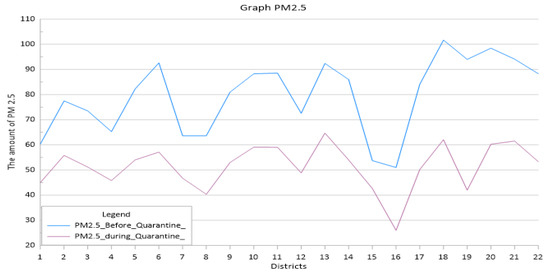
Chart 2.
PM2.5 concentrations before and during the lockdown in the 22 urban regions.
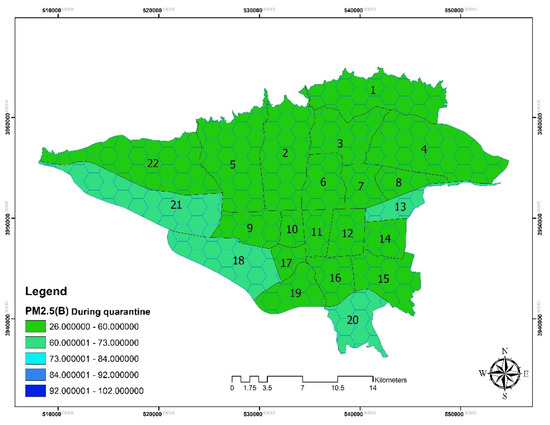
Figure 4.
PM2.5 concentrations before quarantine in Tehran. Drawing authors, 2022.
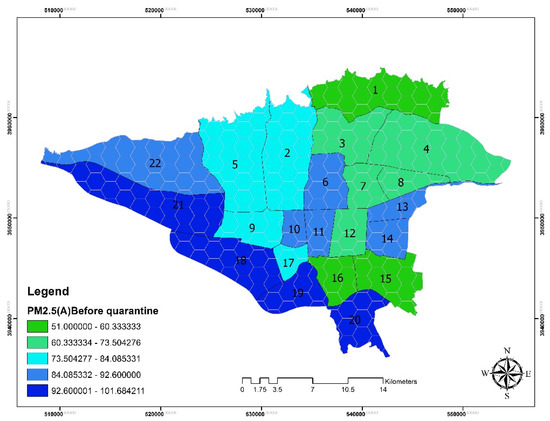
Figure 5.
PM2.5 concentrations during quarantine in Tehran. Drawing authors, 2022.
3.3. PM10 Concentration before and during the Lockdown of 20 March 2020
Table 2 demonstrates the average PM10 concentration from March 2020 to April 2021, along with the three-level quarantine. Considering the significant share of transportation in air pollution in Tehran, a considerable part of these pollutants includes particles with diameters smaller than 2.5 micros. As the Chart and the table illustrate, these pollutants have had their lowest concentration over March–May 2020 and April 2020 and increased to their highest monthly average levels in December, due to the stability of the atmospheric conditions and the accumulation of pollutants. April and May generally experience the lowest concentration of these pollutants due to the geographical conditions of Tehran. Higher concentrations are observed in the hot and dry months due to the increase in the release of dust; however, this was not observed as strongly as before in 2020. On the other hand, evidence suggests that considering the peak in the spread of COVID-19 and the restriction of job commutes from April to June, many factories and industrial sites were closed; urban and cross-city travels were extremely limited and controlled in Tehran. This resulted in the lowest PM10 pollutant concentration recorded by Tehran’s air quality control stations over this period.
Chart 3 illustrates the average concentration of the PM10 pollutant obtained from various stations in the 22 urban regions of Tehran during the quarantine. As demonstrated in Chart 1 and Chart 3, the PM10 pollutant concentration in Tehran has had a persistent declining trend, but dropped to around 7.1% lower than its 2019 level in 2020 and 2021. However, the interpretation of the Charts indicates that despite the relative improvement in Tehran air quality in terms of the daily standard, the concentration of this pollutant was higher than the annual Iranian standard (the red line at 20 ) across all the regions, which has put Tehran in an adverse situation in 2020. Moreover, Table 1 indicates that a similar trend had occurred in all Tehran urban regions regarding the decline in PM10 pollutant concentration over the spread of COVID-19 and the first urban lockdown in Tehran. However, region 1 had the lowest pollutant concentration at 43.95 and region 18 had the highest concentration with 83 before March 2020 and the start of the nationwide lockdown. This trend resulted in the decline in pollutants in all regions –albeit in significantly different amounts in some cases- with the beginning of the 20-day quarantine.
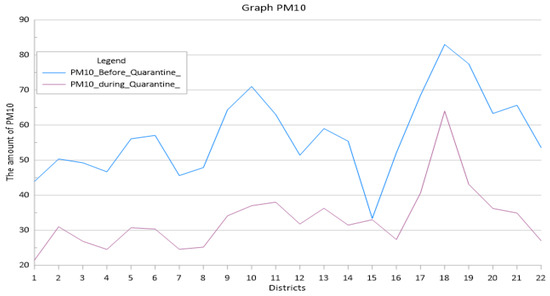
Chart 3.
The PM10 pollutant concentration before and during the lockdown in the 22 urban regions.
Meanwhile, regions 19 and 10 had the most significant change, with 43.37 and 34 , respectively. In contrast, region 15 recorded the most insignificant change due to the 20 March lockdown with 0.35 . Thus, it must be mentioned that the 2020 prevention measures taken by the Iranian government, the decline in the use of automated vehicles, the reduction of urban traffic, the decrease in the use of taxis and public transportation, and the dropped industrial and construction activities—particularly in region 19—have played parts in the reduction of the PM10 load when evaluating whether the lockdown has influenced the air pollution level in Tehran metropolis, compared to the meteorological changes in the 2011–2019 period. Besides, a summarized Chart demonstrates that the PM10 pollutant has the highest concentration compared to the other pollutants and is among the essential air pollutants of cities (Figure 6 and Figure 7).
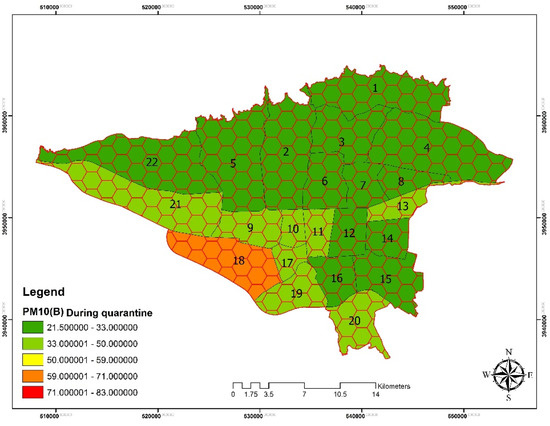
Figure 6.
PM10 concentration before quarantine in Tehran. Drawing authors, 2022.
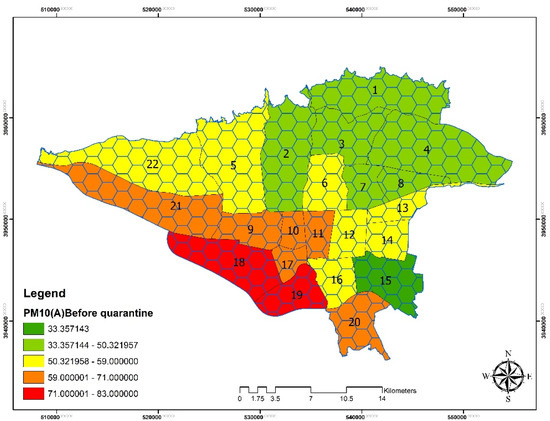
Figure 7.
PM10 concentration during quarantine in Tehran. Drawing authors, 2022.
3.4. NO2 Pollutant Concentration before and during the 20 March 2020, Lockdown
Nitrogen dioxide (NO2) is a toxic gas from factories and car engines. The World Health Organization has announced that if this gas’s concentration exceeds 200 ppb, it can result in respiratory inflammation and lead to asthma [61]. The primary nitrogen dioxide sources include fossil fuel combustion, which produces thermal nitrogen oxide (NO2). The nitrogen receives enough heat alongside oxygen in this process, so the oxygen is oxidized. Other fuel nitrogen oxides (NOx) are released from the chemical structure of the fuel in the fuel combustion process [73]. The results of the studies conducted in various countries such as Pakistan, China, India, Spain, the US, Italy, and many other countries mentioned in Table 2, indicate that the COVID-19 pandemic at the beginning of 2020 resulted in a significant decline in this pollutant (40–50%) across the world, due to the stoppage of industrial activities and the reduction of motor vehicle usage. Despite the problems caused by the disease, the NO2 emission declined by around 44% in 2020 and 2021, due to the implementation of strict traffic control strategies, reduced car fuel consumption, and reduced urban traffic by about 70% in Tehran, compared to 2007 when it used to be among the most polluted cities of the world. Table 2 demonstrates the average NO2 concentration from March 2020 to April 2021, along with the three-level quarantine in the Tehran metropolis. Results indicate that the average NO2 concentration measured in Tehran decreased by around 26.38 ppb over the 20-day lockdown (April 2020), compared to the corresponding trend in February 2020. It must also be mentioned that the average NO2 concentration is generally lower in the early months of spring compared to the cold months of the year, due to the atmospheric stability and the lack of suitable atmosphere currents, which results in the highest monthly concentrations. Still, March and April 2020 marked the lowest pollution level compared to the previous decade. Therefore, these results can reveal the lockdown’s significant role in reducing pollution resulting from NO2 emissions in Tehran.
Chart 4 demonstrates the annual average NO2 concentration obtained from various stations across the 22 urban regions during the quarantine. As indicated in Chart 4, the NO2 concentration in the Tehran metropolis has persistently declined since 2011, but dropped by 8.1% in 2020 and 2021 compared to the corresponding average in 2019. This trend can confirm the positive influence of COVID-19 on Tehran’s air quality across all 22 urban regions. Besides, the comparison of the values obtained from Table 1 to annual Iranian standards (the red line at 53 ppb) reveals that all urban areas were exposed to concentrations higher than the standard before the lockdown of 20 March; however, all the regions except for regions 9 and 13, with the values of 51.1 and 59.26 ppn, experienced a relatively better condition and met the standards over the 20-day lockdown. Among these regions, regions 10 and 16 had the lowest concentration of 29 ppb. A significant decrease in motor vehicles was observed on the streets. The fuel consumed through human activities dropped after implementing the three-level quarantine from 20 March to 10 April 2020, which resulted in a noticeable improvement in air quality in regions 10 and 16. These two regions—particularly region 10—are among the city’s central and most crowded areas and always had high NO2 concentrations before the lockdown (74 ppb in region 10 and 65 ppb in region 16). However, the significant role that the spread of COVID-19 and the controlling measures taken against it have played in this decline, is evident (Figure 8 and Figure 9).
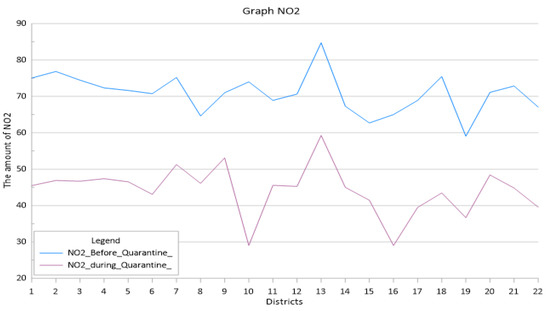
Chart 4.
The concentration of NO2 pollutants before and during the lockdown in the 22 urban regions.

Figure 8.
NO2 concentration before quarantine in Tehran. Drawing authors, 2022.
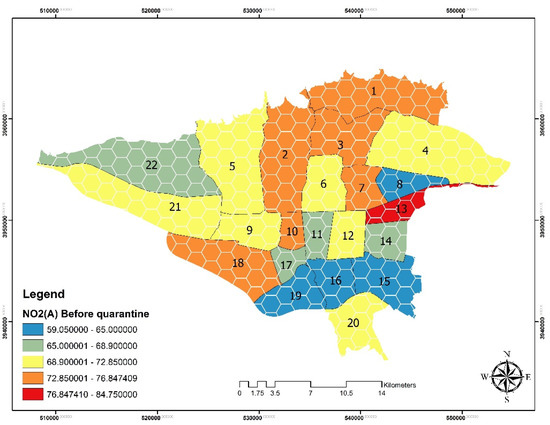
Figure 9.
NO2 concentration during quarantine in Tehran. Drawing authors, 2022.
3.5. O3 Pollutant Concentration before and during the 20 March 2020 Lockdown
Ozone is a gas found both in the troposphere and the stratosphere. While stratosphere ozone acts as a shield against ultraviolet radiations, troposphere ozone is considered among the secondary pollutants produced through the photochemical reactions between nitrogen oxides (NOx) and volatile organic compounds (VOCs) resulting from solar radiations. Thus, this pollutant has the highest monthly concentration in the year’s warm months and declines noticeably in the months when the solar radiations drop in intensity. Troposphere ozone has a significant share in climate change as a greenhouse gas [63]. The formation of troposphere ozone is determined based on the relative concentration of its components in the atmosphere and the local and regional meteorological conditions. Therefore, the diversity in the heat level of the air, wind speed and direction, relative humidity, and rain resulting from climate change, can significantly impact the formation, distribution, and the stability of ozone in the troposphere. The troposphere ozone has increased over recent centuries due to human activities such as transportation, industrial procedures, and energy production. The average O3 concentration and the number of days with ozone concentration higher than the standard amount, are predicted to increase in urban regions across the world due to the acceleration of climate change, which can potentially leave negative impacts on human respiratory health [74,75,76].
Meanwhile, the results of many studies (Table 2) reveal that contrary to other pollutants, not only did the troposphere ozone not decline along with the COVID-19 spread and the urban lockdowns, but it also increased significantly, so that the average daily ozone concentration in Barcelona had risen from 29% to 58% during urban restrictions and lockdown [34]. Data obtained from urban stations in Malaysia indicate that the ozone concentration increased by around 7.3% in 2020 compared to 2019 [34]. Despite the differences observed in these results in various parts of the world. this phenomenon can be justified as a result of the decline in NOx levels of human origin in urban areas with limited VOC, since it results in decreased local Nox titration, which leads to increased average ozone concentration and stability in the environment [34]. This pollutant’s situation in the Tehran metropolis over the 20 days of 20 March to 10 April 2020, is now mentioned further. Chart 5 and Table 2 demonstrate the average O3 concentration over March 2020–April 2021 and the three-level quarantine in the Tehran metropolis. It is evident in Chart 5 and Table 2 that ozone concentration has fluctuated significantly compared to the other pollutants in Tehran. Besides, the decrease observed in the average concentration of PM10, PM2.5, CO2, SO2, and NO2, due to the COVID-19 pandemic and the urban lockdown cannot be kept; in terms of ozone we observed higher ozone concentrations in March when the lockdown started. The concentration reaches its peak when moving towards June and July to the point that a concentration of 108 ppb was recorded in June 2020. Therefore, the lockdown and traffic restrictions did not significantly reduce ozone, contrary to other air pollutants. The decline in NO2 has even contributed to the increase in ozone.
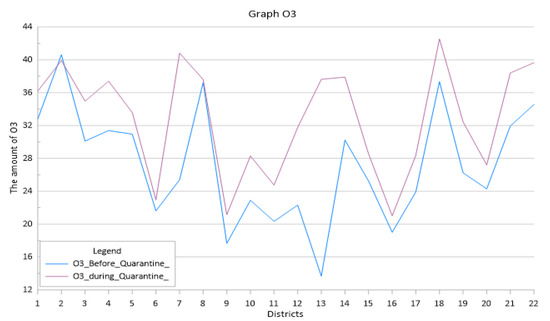
Chart 5.
The concentration of O3 pollutants before and during the lockdown in the 22 urban regions.
Chart 5 illustrates the average ozone concentration obtained from various stations in the 22 urban regions of Tehran during the lockdown. Although Chart 1 demonstrates a declining trend for O3 concentration in Tehran during 2011–2021, the peak monthly concentration during this period was observed in July 2020, followed by June 2019. Moreover, Chart 5 indicates that all the urban regions had lower ozone concentrations before the lockdown, except for region two, which underwent a 0.7 ppb decrease in ozone concentration during the quarantine. The rest of the areas experienced an increase in O3 during the lockdown, among which regions 7 and 13, with respective increases of 15.4 and 23.9 ppb, had the most significant growth. These results can be referred back to the complex mechanism behind troposphere O3 formation, which depends on various parameters such as VOC/NOx, and the O3 concentration increases as a result of the added titration effect (NO + O3 = NO2 + O2) with the decrease in O3 precursors such as NOx. This is why the VOC/NOx ratio is low in crowded urban areas with high NOx levels. If the NOx concentration drops significantly under such circumstances, the complex photochemical reaction mechanism favors O3 formation. This can even be observed in Chart 5. As indicated, urban regions with high traffic (regions 7 and 13 adjacent to regions 6 and 12) undergo increased O3 concentration. Thus, COVID-19 has negatively affected air quality despite its positive influence on pollution. It must be mentioned that the troposphere ozone, which increases in the year’s warm seasons, have also contributed to those mentioned above since the lockdowns took place in April and March (Figure 10 and Figure 11).
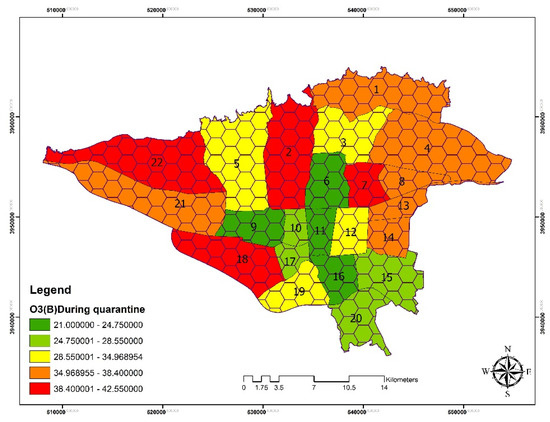
Figure 10.
O3 concentration before quarantine in Tehran. Drawing authors, 2022.
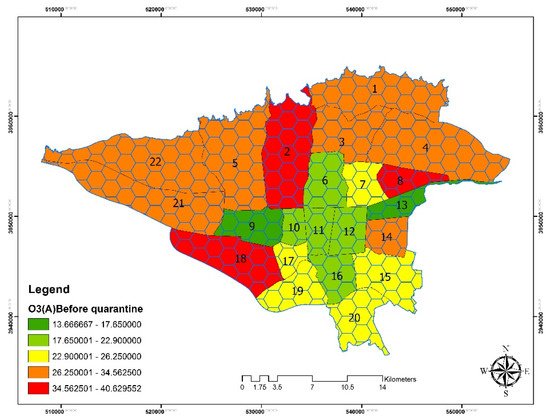
Figure 11.
O3 concentration during quarantine in Tehran. Drawing authors, 2022.
3.6. SO2 Pollutant Concentration before and during the 20 March 2020 Lockdown
Sulfur dioxide is a clear and non-combustible gas with an irritating and burning odor of around 3 ppm. Sulfur trioxide is a highly active clear gas that can easily condense into a liquid and cannot be found in the atmosphere under normal circumstances. It reacts quickly with humidity and turns into sulfuric acid [73]. Given the significant share of industrial sources, such as refineries and power plants in SO2 emission, the changes in this pollutant are influenced by the amount and quality of the fuel used in industries, on top of the changes in the effective traffic load, particularly in the cold seasons of the year [77]. The results of the studies summarized in Table 2 indicate that SO2 declined just like other air pollutants in many parts of the world with COVID-19 and the subsequent instructions to control and prevent the spread of the disease. The emission of the contaminant has declined—albeit slightly—with the suspension and closure of many industrial activities and power plans using coal. However, Brazil and Italy underwent increases of 8 and 1.8% in this pollution, contrary to other countries.
In comparison, China observed a 53% decrease in SO2 concentrations due to the strict regulation against COVID-19. Still, it is noteworthy that Wuhan only underwent a 3.9% decrease in SO2, contrary to expectations. Moreover, Tehran experienced a favorable decline in this pollutant, with a reduction of 28%. The concentrations of this pollutant in the Tehran metropolis will be analyzed further. Table 2 demonstrates the average SO2 concentration from March 2020 to April 2021, along with the three-level quarantine in the Tehran metropolis. Results indicate that SO2 concentration dropped by 7 ppb during the 20-day lockdown period in March 2020, and ended in April. However, as September approached, the concentration underwent an increasing trend and returned to its declining trend in the consequent rise and fall period in March 2021. This pollutant increased in concentration as we approached the cold months of the year. Despite the declining trend of SO2, Chart 6 demonstrates its noticeable increase in November, December 2020, and January 2021. Overall, results indicate that the COVID-19 pandemic and the resulting lockdowns positively influenced this pollutant’s decline.
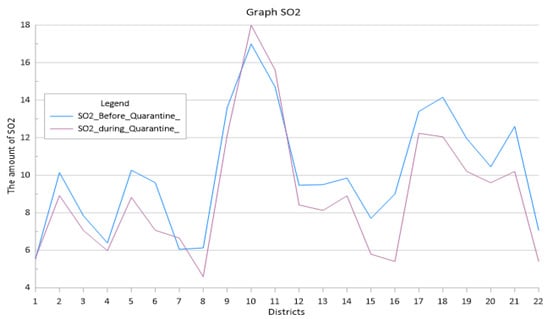
Chart 6.
The concentration of SO2 pollutants before and during the lockdown in the 22 urban regions.
Chart 6 demonstrates the annual SO2 concentration obtained from various stations in the 22 urban regions of Tehran during the lockdown. Although Chart 1 shows a relatively declining trend for SO2 concentration in Tehran during 2011–2021, it has not gone through many fluctuations in these 10 years. It has had smaller values than other pollutants, including PM10, PM2.5, NO2, and SO3. On the other hand, it can be observed in Chart 6 that SO2 concentration has not changed significantly during the lockdown of 20 March–10 April, so the range of change is limited to 1–2.5 ppb. Meanwhile, the table reveals that regions 1, 7, 10, and 11 have gone through an insignificant increase in this pollution. Although region 11 had the highest SO2 concentration in February 2020, it had the highest concentration at 15.6 ppb during the lockdown, and region 22 had the lowest SO2 concentration at 5.4 ppb. There is currently no annual standard for this pollutant; the latest Iranian standard is seven ppb, demonstrating that only regions 1, 4, 7, and 8 had SO2 concentrations lower than this amount before the lockdown, and that region 16 joined these regions during the lockdown. Overall, results indicate that heavy diesel-powered vehicle traffic and the use of heavy fuels rich in sulfur in industries play a significant part in increasing the concentration of this pollutant. Given the closure of many industries and restrictions on the traffic of heavy vehicles in urban areas during the lockdown, the sulfur content of the distributed fuel in Tehran decreased significantly, resulting in a low distributed sulfur in the gasoline consumed in the city. Thus, the declining trend in the concentration of this pollutant is predicted to continue if the sulfur concentration in the gas consumed by heavy vehicles and bus refuels in other parts of the country declines. Besides, constant monitoring and supervision over the quality of the fuel used in industries can also significantly control and reduce this pollutant during the post-corona period (Figure 12 and Figure 13).
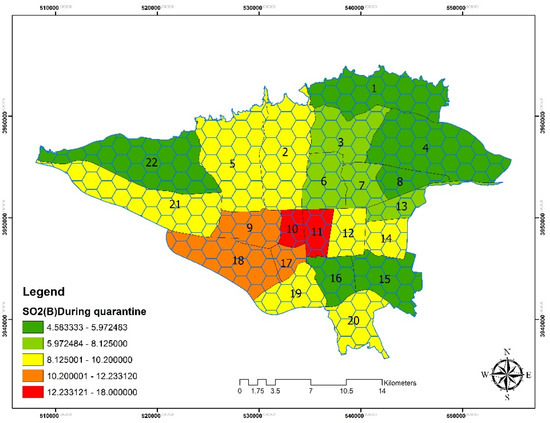
Figure 12.
SO2 concentration before quarantine in Tehran. Drawing authors, 2022.
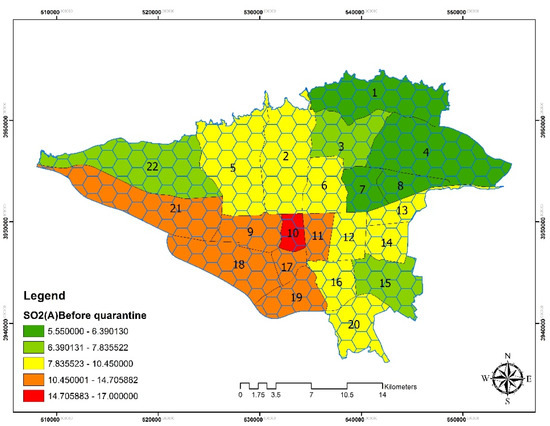
Figure 13.
SO2 concentration during quarantine in Tehran. Drawing authors, 2022.
3.7. CO Pollutant Concentration before and during the 20 March 2020 Lockdown
Carbon monoxide is a clear, odorless, tasteless gas resulting from incomplete coal and fossil fuel combustion. The incomplete combustion of these fuels produces carbon monoxide instead of carbon dioxide. Carbon monoxide concentration depends on the traffic load in urban areas and changes in various weather. Over 70% of the carbon monoxide released into the air is the product of vehicle transportation [64]. Table 2 demonstrates that the concentration of this pollution increased considerably in late 2019 and early 2020 (especially since March) due to the decrease in urban traffic following the COVID-19 pandemic and the urban lockdown.
The study in 2020 reported a 36.84% Co decline in the Delhi metropolis, India, following the COVID-19 outbreak and the closure of the roads, power plants, and manufacturing industries during the lockdown. Besides, a 5% decrease in CO concentration was reported in Cairo and Eskandarieh, Egypt, in 2020 compared to 2015–2019. A similar trend has been observed in many cities and countries such as China [33], South and Central India [78], Rio de Janeiro [79], Sao Paulo [80], Milan, and Tehran, reporting a 13–50% decline in CO concentration during the COVID-19 pandemic, resulting in strict transportation control measures, traffic restrictions, and reduced industrial emission. The CO pollutant concentration in the Tehran metropolis will now be analyzed further. Table 2 demonstrates the average CO concentration from March 2020 to April 2021, along with the three-level lockdown in Tehran. As observed in Table 2, the average Co concentration has been within standard limits throughout 2020 and has not resulted in any problems for the city. However, it reached its bottom in March 2020, at the same time as the urban lockdown, and has been slightly increasing since then. This pollutant is the product of incomplete fuel combustion. It has declined during the lockdown due to the urban traffic restrictions that led it to remain within reasonable limits; however, CO2 concentration peaks in the year’s cold months due to air inversion and atmosphere stability. Thus, January 2020 marks the highest, and April 2020 marks the lowest CO concentration during the lockdown.
Chart 7 illustrates the annual average CO concentration obtained from various stations in the 22 urban regions of Tehran during the lockdown. Although Chart 1 demonstrates a relatively declining trend for SO2 concentration in Tehran during 2011–2021, a slight increase in its concentration can be observed in 2014. However, it can be seen that the CO concentration in the Tehran metropolis has marked its lowest figures between 2020 and 2021. The Chart also demonstrates the difference between average CO concentrations in various regions of the Tehran metropolis. As the Chart indicates, the CO concentration has declined in all the areas since the 20 March lockdown.
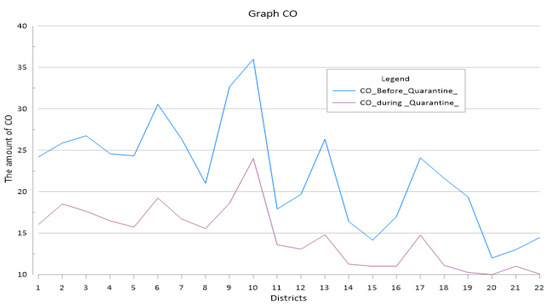
Chart 7.
CO pollutant concentration before and during the lockdown in the 22 urban regions.
Meanwhile, the highest CO concentrations were observed in regions 10 (24 ppb), 9 (18.6 ppb), 2 (18.6 ppb), and 3 (17.6 ppb). These regions are among the regions with the highest exposure to traffic and thus have marked higher pollutant concentrations, mainly in the central and crowded parts of the city. The lowest CO concentration has also been recorded in region 20 (10 ppb). Overall, no area has had CO concentrations higher than the standard, considering that no annual standard has been defined for this pollutant due to its instability, highlighting the positive impact of the COVID-19 pandemic on Tehran’s air quality in 2020. To sum up, since carbon monoxide is emitted mainly by moving sources, the implementation of solutions controlling pollution resulting from incomplete combustion, such as the repair and maintenance of automobiles, preventing incomplete combustion, the elimination of carburetors from motorcycles and cars, and the use of catalysts in automobiles, can have a significant impact on reducing the concentration of this pollutant in Tehran metropolis during the post-corona period (Figure 14 and Figure 15).
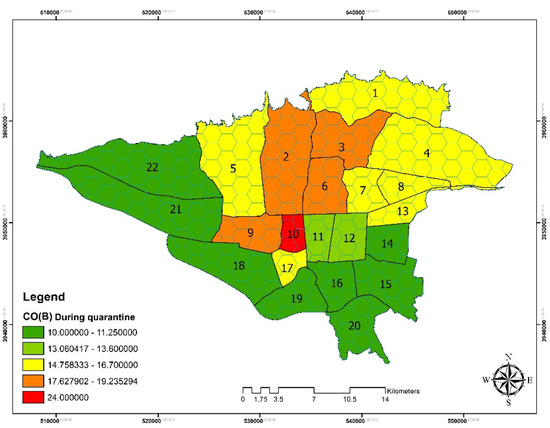
Figure 14.
CO concentration before quarantine in Tehran. Drawing authors, 2022.
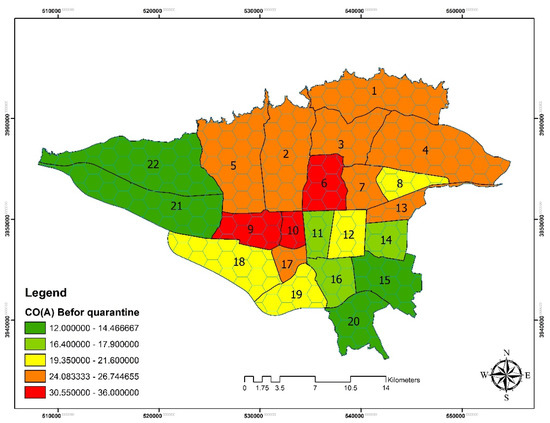
Figure 15.
CO concentration during quarantine in Tehran. Drawing authors, 2022.
4. Air Quality Index (AQI)
The average AQI is dimensionless to announce and predict the daily air quality calculated based on the American Environment Protection Association in Iran [64]. A typical AQI is an interpretive technique that transfers the complex data of measured air pollutant concentration into a single number, or a set of numbers, to make the data more understandable [81].
High AQIs demonstrate that not only does the severe and condensed pollution in the air affect outdoor human activities, but it also damages their health and leads to cardiac, vascular, and respiratory diseases. The aforementioned table shows that this index relatively improved in 2020 at the same time as the COVID-19 pandemic, compared to 2015–2019. The improvement reached 30% in some parts of the world. On the other hand, the most significant number of healthy-air days over the past 10 years have also been observed in 2020 and 2021. For instance, Iran has had a favorable condition, with 20 healthy and 226 good days from March 2020 to March 2021. Table 3 demonstrates the air quality index from March 2020 to April 2021, simultaneously with the three-level quarantine in the Tehran metropolis. As evident, the lowest AQI index was recorded in March 2020 compared to the days before and after, so the most significant number of days with healthy air was observed in April, with an index of 63. None of the days in March and April 2020 had AQIs higher than the standard levels, due to the decrease in urban traffic and fine dust emission, which indicates a relative improvement in the AQI condition. However, the index increased in number along with the weather getting warmer, and photochemical reactions resulting in ozone getting easier, so that a considerable number of days had unfavorable AQI over June-August; the highest AQI in Tehran was recorded on 20 July at 161, when the air quality was unhealthy for all groups. In the second half of the year, specifically from October to late December, the number of days with unfavorable air quality increased, similar to previous years, due to more stable weather conditions, the relative stability of the atmosphere, and reduced temperature. Among the unhealthy days, the highest index belonged to PM2.5 particulate matter. Still, the study results indicate that the PM2.5 concentration was at its lowest level during the quarantine, and the air quality index was at a reasonable level during this time.

Table 3.
Air quality index from March 2020 to April 2021.
Chart 8 demonstrates the quality of air index in the Tehran metropolis based on the American Environmental Protection Association index obtained from various stations in the 22 urban regions of the Tehran metropolis during the quarantine. The Chart demonstrates a relative improvement in all regions’ air quality in March and since the beginning of the quarantine. Among the urban regions, regions 20, 6, 22, and 21 significantly declined this index by 36.85, 34.92, 33.4, and 31.8, respectively. Besides, regions 1, 15, 7, and 14 had the smallest decline by 3.3, 5.9, 5.8, and 8, respectively. It must also be mentioned that considering the standard of the American Environmental Protection Association (2018), only region 1 was considered a healthy region both before and after the COVID-19 pandemic, with AQI indices of 49.3 and 43. Region 16 was considered acceptable in terms of AQI with an index of 52.1, but improved to a healthy state with an AQI of around 27.35 since 20 March (Figure 16 and Figure 17).

Chart 8.
AQI indicator concentration before and during the lockdown in the 22 urban regions.
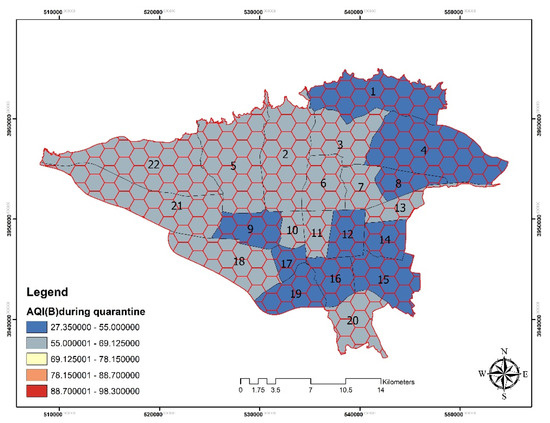
Figure 16.
AQI concentration before quarantine in Tehran. Drawing authors, 2022.

Figure 17.
AQI indicator concentration during quarantine in Tehran. Drawing authors, 2022.
5. Discussion and Conclusions
The spread of the COVID-19 pandemic worldwide has influenced the mutual bond between humans and nature in various ways. Many countries’ governments have responded to this pandemic by implementing various restrictions ranging from people’s daily activities to transportation restrictions. These measures have left influences—albeit temporary—on the natural environment. They have improved air quality in many cities in Europe, Brazil, India, China, Saudi Arabia, the USA, and Iran. Therefore, the decrease in this pollution level has saved the lives of many who lost their lives due to air pollution every year. Meanwhile, global evidence reveals that apart from its negative impacts, the COVID-19 spread has resulted in a decline in air pollutant emissions through disrupting excessive industrial and economic activities, transportation restrictions, the reduced demand for energy from the service sector, a slight decrease in nitrates, and the improved condition of oxygen dissolved in water sources, which can be considered as its positive outcomes.
Still, these short-term impacts can be considered the results of the short-term measures taken by governments to fight against COVID-19. The situation before the pandemic will return after the quarantine to everyday life and old habits. However, evidence suggests the current lifestyle and energy consumption preference under economic and social changes. For instance, many employees have been forced to telecommute due to quarantine, which has resulted in improved local air quality due to lower traffic. But will this lifestyle persist after the end of the quarantine and the control of COVID-19? Will the employees still be willing to work from home? Will their company prefer them to be present at the workplace? Will consumers try to reduce their consumption despite advertisements encouraging them to consume more? These questions indicate that COVID-19 has created a new lifestyle that has nudged humans towards green and sustainable development and lifestyle. However, a cultural, social, and economic change in the citizens’ approach and consumption style, and a reformation of management styles and institutions, are required to facilitate this transition. These changes will create a new lifestyle based on more sustainable or less frequent travel.
So far, many operational plans with large scales and costs, and topics such as climate change or the global community’s support of global warming, have been implemented by developed countries. Still, COVID-19 and its quarantine have led to the unconscious emergence of these programs worldwide. Still, there appears to be an increasing concern that the attempt to increase consumption as part of the Keynesian policies will worsen the ecological problems in the post-corona era. The relationship between GDP and gas emissions is so strong that any increase in production will produce more pollution emissions. Two-thirds of citizens in the world feel that the climate crisis can be as severe and dangerous as COVID-19. This can indicate the solid public support behind integrating ecological goals in each recovery strategy in the post-corona period. Therefore, the COVID-19 pandemic can contribute to environmental sustainability, social responsibility, and people’s quality of life. It is significant that public health all around the world has changed due to environmental awareness and inclination towards sustainable consumption. Additionally, the social actions of people have changed effectively in the post-corona era because of quarantine, social isolation, and the health crisis due to the pandemic.
Thus, in the framework of the COVID-19 pandemic, sustainable development is considered a key solution and concept in creating a promising and prosperous future for human communities; where sustainable development must be the global strategy since natural preservation must be sustainable, so that the next generations can cover their needs.
Therefore, in this article, the COVID-19 crisis was considered a unique opportunity to move toward a greener, more sustainable, and equitable society to prevent land extinction and increase social welfare. Thus, such a crisis became a factor in stabilizing the world for future generations. To achieve this, we must first reorganize our worldview and examine the governance and role of citizens at different scales to achieve such a goal, because this requires a comprehensive effort, which is possible only achievable with extensive cooperation between communities.
Furthermore, this paper examines the relationship between the challenges of the COVID-19 crisis and the shift toward environmental sustainability. The most important conclusions of our research can be summarized as follows.
We first examine how the COVID-19 crisis affects the transition to environmental sustainability. It can be argued that such a crisis creates a potential opportunity for social change. However, it is unclear in advance under what conditions and to what extent this change will occur, and whether the decision to change will lead to the desired path. Change towards environmental sustainability, or not? To achieve this, and the transition to environmental sustainability, it is necessary to form a clear and purposeful political framework to guide investment and the behavior of citizens and institutions.
In other results of this study, we stated that maybe there are structural similarities between the crises of COVID-19 and the environment. These can let us deal with the environmental crisis if there are similarities.
Strategies to combat COVID-19 have ranged from social distancing to reducing road traffic worldwide. Additionally, the structural differences in various countries make reducing environmental crises more challenging than reducing COVID-19. As a result, many strategies used to deal with the COVID-19 problem (for example, quarantines) to achieve environmental sustainability, are problematic.
According to the result of the study, how the transition to environmental sustainability in the post-corona period will effectively improve the climate of the Tehran metropolitan area, is of prime importance. Regarding the results of the analysis, the change to sustainable development, both in reducing environmental degradation and in creating socio-technological resilience in the post-corona era, requires a fundamental strategy for the formation of sustainable environmental behavior, placing the idea of sustainable development in the minds of all citizens and city managers, in order to form a sustainable future for all. Although the level of air pollutants decreased during the outbreak of COVID-19, it needs to be pursued in the post- COVID-19 period, creating a greener and more sustainable environment for cities.
Implementing part of the 17 sustainable development goals could be crucial in reducing COVID-19 risk, improving the quality of public health, and building a sustainable city.
Thus, in the framework of the COVID-19 pandemic, sustainable development is considered a key solution and concept in creating a promising and prosperous future for human communities. Sustainable development must be the global strategy since natural preservation must be sustainable, so that successive generations can cover their needs.
Several suggestions are proposed for this, as follows:
- Offering financial incentives for resistance economy and further sustainability: such strategies can include vast, broad conditions for sectors that have been heavily impacted by the COVID-19 crisis, such as airlines, automobile manufacturing, and the textile sector. Further investments include investment in renewable energy projects, sustainable movement solutions, and risky investment for new companies developing innovative green technologies.
- Financial incentives that reduce environmental damage and climate changes: governments can change taxes from the “positive” (labor force, income, innovation) to “negative” (environmental pollution, fossil fuel energy, reduction of waste and material resources) areas. Governments can also encourage sustainable behavior, such as refraining from unnecessary travel, reusing materials and products, and making supply chains green for citizens and firms through rewards, such as financial measures that promote good behaviors.
- Governments’ political intervention: creating motivation and incentives to make citizens incline towards environment-friendly transportation modes, such as the use of hybrid or electronic automobiles and the use of bikes instead of vehicles running on fossil fuels, and changing citizens’ behaviors towards the use of public transportation instead of private vehicles.
Increasing the potential and influence of working at home or replacing the commute with telecommuting.
The further investment of governments in technological sectors and digital and internet infrastructure to reduce the need for travel. Not only will such investments reduce the risk of COVID-19 through telecommuting, but they will also result in economic improvement and create shared interests with the environment, directly and indirectly.
The overall decline in energy demand from commercial and industrial sectors and increasing the use of renewable energy and governments’ investment in green energy in various sectors, such as transportation infrastructures.
Author Contributions
Data curation, E.F., B.A.M., M.D., B.M. and L.S.; Formal analysis, S.T., M.D. and L.S.; Funding acquisition, B.A.M., B.M. and L.S.; Investigation, S.T., M.A., H.T.M., M.D., B.M. and L.S.; Methodology, S.T. and E.F.; Software, E.F. All authors have read and agreed to the published version of the manuscript.
Funding
The authors declare that they have no funding source.
Institutional Review Board Statement
Not applicable.
Informed Consent Statement
Not applicable.
Data Availability Statement
The data will be available on request to the corresponding author.
Conflicts of Interest
The authors declare no conflict of interest. All authors certify that they have no affiliations with or involvement in any organization or entity with any financial interest or non-financial interest in the subject matter or materials discussed in this manuscript.
References
- Johnston, A.S.; Boyd, R.J.; Watson, J.W.; Paul, A.; Evans, L.C.; Gardner, E.; Boult, V. Predicting population responses to environmental change from individual-level mechanisms: Towards a standardized mechanistic approach. Proc. R. Soc. B 2019, 286, 20191916. [Google Scholar] [CrossRef] [PubMed]
- Cremades, R.; Mitter, H.; Tudose, N.C.; Sanchez-Plaza, A.; Graves, A.; Broekman, A.; Bender, S.; Giupponi, C.; Koundouri, P.; Bahri, M.; et al. Ten principles to integrate the water-energy-land nexus with climate services for co producing local and regional integrated assessments. Sci. Total Environ. 2019, 693, 133662. [Google Scholar] [CrossRef] [PubMed]
- Safdari Molan, A.; Farhadi, E.; Saganeiti, L.; Murgante, B. Border Tourism Development Strategies in Kaleybar Compared to Regional Rivals. Sustainability 2021, 13, 11400. [Google Scholar] [CrossRef]
- Hataminejad, H.; Abdul, A.Y.; Farhadi, E.; Hossaini, F. An investigation of the life quality indices for improving the mental health of the citizens of Kaleybar in Iran. Int. J. Sci. Res. Sci. Eng. Technol. 2016, 1, 571–581. [Google Scholar]
- Peters, K.; Peters, L.E.R. Terra incognita: The contribution of disaster risk reduction in unpacking the sustainability–peace nexus. Sustain. Sci. 2021, 16, 1173–1184. [Google Scholar] [CrossRef]
- Hussaini, F.; Farhadi, E.; Pourahmad, A.; Tondelli, S. Spatial justice in relation to the urban amenities distribution in Austin, Texas. Spat. Inf. Res. 2022, 9, 1–12. [Google Scholar] [CrossRef]
- Madhav, N.; Oppenheim, B.; Gallivan, M.; Mulembakani, P.; Rubin, E.; Wolfe, N. Pandemics: Risks, impacts, andmitigation. In Disease Control Priorities: Improving Health and Reducing Poverty, 3rd ed.; The International Bank for Reconstruction and Development: Washington, DC, USA; The World Bank: Washington, DC, USA, 2017. [Google Scholar]
- Coccia, M. Effects of the spread of COVID-19 on public health of polluted cities: Results of the first wave for explaining the dejà vu in the second wave of COVID-19 pandemic and epidemics of future vital agents. Environ. Sci. Pollut. Res. 2021, 28, 19147–19154. [Google Scholar] [CrossRef]
- World Health Organization. Coronavirus Disease 2019 (COVID-19): Situation Report, 73; WHO: Geneva, Switzerland, 2019.
- Rume, T.; Islam, S.D. Environmental effects of COVID-19 pandemic and potential strategies of sustainability. Heliyon 2020, 6, e04965. [Google Scholar] [CrossRef]
- Zhou, P.; Yang, X.L.; Wang, X.G.; Hu, B.; Zhang, L.; Zhang, W.; Si, H.R.; Zhu, Y.; Li, B.; Huang, C.L.; et al. A pneumonia outbreak associated with a new coronavirus of probable bat origin. Nature 2020, 579, 270–273. [Google Scholar] [CrossRef]
- Lian, X.; Huang, J.; Huang, R.; Liu, C.; Wang, L.; Zhang, T. Impact of city lockdown on the air quality of COVID-19-hit of Wuhan city. Sci. Total Environ. 2020, 742, 140556. [Google Scholar] [CrossRef]
- Qiu, Y.; Chen, X.; Shi, W. Impacts of social and economic factors on the transmission of coronavirus disease 2019 (COVID-19) in China. J. Popul. Econ. 2020, 33, 1127–1172. [Google Scholar] [CrossRef] [PubMed]
- Conticini, E.; Frediani, B.; Caro, D. Can atmospheric pollution be considered a co-factor in extremely high level of SARS-CoV-2 lethality in Northern Italy? Environ. Pollut. 2020, 261, 114465. [Google Scholar] [CrossRef] [PubMed]
- Domingo, J.L.; Marquès, M.; Rovira, J. Influence of airborne transmission of SARS-CoV-2 on COVID-19 pandemic. A review. Environ. Res. 2020, 188, 109861. [Google Scholar] [CrossRef]
- Deiana, G.; Azara, A.; Dettori, M.; Delogu, F.; Vargiu, G.; Gessa, I.; Stroscio, F.; Tidore, M.; Steri, G.; Castiglia, P. Deaths in SARS-CoV-2 Positive Patients in Italy: The Influence of Underlying Health Conditions on Lethality. Int. J. Environ. Res. Public Health 2020, 17, 4450. [Google Scholar] [CrossRef] [PubMed]
- Murgante, B.; Borruso, G.; Balletto, G.; Castiglia, P.; Dettori, M. Why Italy first? Health, geographical and planning aspects of the COVID-19 outbreak. Sustainability 2020, 12, 5064. [Google Scholar] [CrossRef]
- Dettori, M.; Deiana, G.; Balletto, G.; Borruso, G.; Murgante, B.; Arghittu, A.; Azara, A.; Castiglia, P. Air pollutants and risk of death due to COVID-19 in Italy. Environ. Res. 2021, 192, 110459. [Google Scholar] [CrossRef]
- Deiana, G.; Azara, A.; Dettori, M.; Delogu, F.; Vargiu, G.; Gessa, I.; Arghittu, A.; Tidore, M.; Steri, G.; Castiglia, P. Characteristics of SARS-CoV-2 positive cases beyond health-care professionals or social and health-care facilities. BMC Public Health 2021, 21, 83. [Google Scholar] [CrossRef]
- Duflot, R.; Baumeister, S.; Burgas, D.; Eyvindson, K.; Triviño, M.; Blattert, C.; Kuparinen, A.; Potterf, M. Building up an ecologically s stainable and socially desirable post-COVID-19 future. Sustain. Sci. 2021, 16, 1397–1403. [Google Scholar] [CrossRef]
- Murgante, B.; Balletto, G.; Borruso, G.; Saganeiti, L.; Pilogallo, A.; Scorza, F.; Castiglia, P.; Arghittu, A.; Dettori, M. A methodological proposal to evaluate the health hazard scenario from COVID-19 in Italy. Environ. Res. 2022, 209, 112873. [Google Scholar]
- Diffenbaugh, N.S.; Field, C.B.; Appel, E.A.; Azevedo, I.L.; Baldocchi, D.D.; Burke, M.; Burney, J.A.; Ciais, P.; Davis, S.J.; Fiore, A.M.; et al. The COVID-19 lockdowns: A window into the Earth System. Nat. Rev. Earth Environ. 2020, 1, 470–481. [Google Scholar] [CrossRef]
- Manzanedo, R.D.; Manning, P. COVID-19: Lessons for the climate change emergency. Sci. Total Environ. 2020, 742, 140563. [Google Scholar] [CrossRef] [PubMed]
- Kapoor, N.R.; Kumar, A.; Meena, C.S.; Kumar, A.; Alam, T.; Balam, N.B.; Ghosh, A. A systematic review on indoor environmental quality in naturally ventilated school classrooms: A way forward. Adv. Civ. Eng. 2021, 2021, 8851685. [Google Scholar] [CrossRef]
- Thu, T.P.; Ngoc, P.N.; Hai, N.M. Effect of the social distancing measures on the spread of COVID-19 in 10 highly infected countries. Sci. Total Environ. 2020, 742, 140430. [Google Scholar] [CrossRef] [PubMed]
- Pata, U.K. How is COVID-19 affecting environmental pollution in US cities? Evidence from asymmetric Fourier causality test. Air Quality, Atmos. Health 2020, 13, 1149–1155. [Google Scholar] [CrossRef]
- Gautam, S. COVID-19: Air pollution remains low as people stay at home. Air Qual. Atmos. Health 2020, 13, 853–857. [Google Scholar] [CrossRef]
- Bashir, M.F.; Ma, B.; Komal, B.; Bashir, M.A.; Tan, D.; Bashir, M. Correlation between climate indicators and COVID-19 pandemic in New York, USA. Sci. Total Environ. 2020, 728, 138835. [Google Scholar] [CrossRef]
- Shehzad, K.; Sarfraz, M.; Shah, S.G. The impact of COVID-19 as a necessary evil on air pollution in India during the lockdown. Environ. Pollut. 2020, 266, 115080. [Google Scholar] [CrossRef]
- Muhammad, S.; Long, X.; Salman, M. COVID-19 pandemic and environmental pollution: A blessing in disguise? Sci. Total Environ. 2020, 728, 138820. [Google Scholar] [CrossRef]
- Dutheil, F.; Baker, J.S.; Navel, V. COVID-19 as a factor influencing air pollution? Environ. Pollut. 2020, 263, 114466. [Google Scholar] [CrossRef]
- Chakraborty, I.; Maity, P. COVID-19 outbreak: Migration, effects on society, global environment and prevention. Sci. Total Environ. 2020, 728, 138882. [Google Scholar] [CrossRef]
- Saadat, S.; Rawtani, D.; Hussain, C.M. Environmental perspective of COVID-19. Sci. Total Environ. 2020, 728, 138870. [Google Scholar] [CrossRef] [PubMed]
- Tobías, A.; Carnerero, C.; Reche, C.; Massagué, J.; Via, M.; Minguillón, M.C.; Alastuey, A.; Querol, X. Changes in air quality during the lockdown in Barcelona (Spain) one month into the SARS-CoV-2 epidemic. Sci. Total Environ. 2020, 726, 138540. [Google Scholar] [CrossRef] [PubMed]
- Wang, Q.; Su, M. A preliminary assessment of the impact of COVID-19 on environment–A case study of China. Sci. Total Environ. 2020, 728, 138915. [Google Scholar] [CrossRef] [PubMed]
- Zambrano-Monserrate, M.A.; Ruano, M.A.; Sanchez-Alcalde, L. Indirect effects of COVID-19 on the environment. Sci. Total Environ. 2020, 728, 138813. [Google Scholar] [CrossRef]
- Shakil, M.H.; Munim, Z.H.; Tasnia, M.; Sarowar, S. COVID-19 and the environment: A critical review and research agenda. Sci. Total Environ. 2020, 745, 141022. [Google Scholar] [CrossRef]
- Yunus, A.P.; Masago, Y.; Hijioka, Y. COVID-19 and surface water quality: Improved lake water quality during the lockdown. Sci. Total Environ. 2020, 731, 139012. [Google Scholar] [CrossRef]
- Barreiro-Gen, M.; Lozano, R.; Zafar, A. Changes in sustainability priorities in organisations due to the COVID-19 outbreak: Averting environmental rebound effects on society. Sustainability 2020, 12, 5031. [Google Scholar] [CrossRef]
- He, G.; Pan, Y.; Tanaka, T. The short-term impacts of COVID-19 lockdown on urban air pollution in China. Nat. Sustain. 2020, 3, 1005–1011. [Google Scholar] [CrossRef]
- Ju, M.J.; Oh, J.; Choi, Y.-H. Changes in air pollution levels after COVID-19 outbreak in Korea. Sci. Total Environ. 2021, 750, 141521. [Google Scholar] [CrossRef]
- Zhang, Q.; Pan, Y.; He, Y.; Walters, W.W.; Ni, Q.; Liu, X.; Xu, G.; Shao, J.; Jiang, C. Substantial nitrogen oxides emission from China due to COVID-19 and its impact on surface ozone and aerosol pollution. Sci. Total Environ. 2021, 753, 142238. [Google Scholar] [CrossRef]
- Roidt, M.; Chini, C.M.; Stillwell, A.S.; Cominola, A. Unlocking the impacts of COVID-19 lockdowns: Changes in thermal electricity generation water footprint and virtual water trade in Europe. Environ. Sci. Technol. Lett. 2020, 7, 683–689. [Google Scholar] [CrossRef]
- Aldaco, R.; Hoehn, D.; Laso, J.; Margallo, M.; Ruiz-Salmón, J.; Cristobal, J.; Kahhat, R.; Villanueva-Rey, P.; Bala, A.; Batlle-Bayer, L. Food waste management during the COVID-19 outbreak: A holistic climate, economic and nutritional approach. Sci. Total Environ. 2020, 742, 140524. [Google Scholar] [CrossRef]
- You, S.; Sonne, C.; Ok, Y.S. COVID-190s unsustainable waste management. Science 2020, 368, 1438. [Google Scholar] [CrossRef]
- Bodenheimer, M.; Leidenberger, J. COVID-19 as a window of opportunity for sustainability transitions? Narratives and communication strategies beyond the pandemic. Sustain. Sci. Pract. Policy 2020, 16, 61–66. [Google Scholar] [CrossRef]
- Sarkis, J.; Cohen, M.J.; Dewick, P.; Schröder, P. A brave new world: Lessons from the COVID-19 pandemic for transitioning to sustainable supply and production. Resour. Conserv. Recycl. 2020, 159, 104894. [Google Scholar] [CrossRef] [PubMed]
- Raj, B.P.; Meena, C.S.; Agarwal, N.; Saini, L.; Hussain Khahro, S.; Subramaniam, U.; Ghosh, A. A review on numerical approach to achieve building energy efficiency for energy, economy and environment (3E) benefit. Energies 2021, 14, 4487. [Google Scholar] [CrossRef]
- Hakovirta, M.; Denuwara, N. How COVID-19 redefines the concept of sustainability. Sustainability 2020, 12, 3727. [Google Scholar] [CrossRef]
- Lehmann, P.; Beck, S.; Brito, M.M.D.; Gawel, E.; Grob, M.; Haase, A.; Lepenies, R.; Otto, D.; Schiller, J.; Strunz, S.; et al. Environmental Sustainability Post COVID-19: Scrutinizing Popular Hypotheses from a Social Science Perspective. Sustainability 2021, 13, 8679. [Google Scholar] [CrossRef]
- Farhadi, E.; Pourahmad, A.; Ziari, K.; Faraji Sabokbar, H.; Tondelli, S. Indicators Affecting the Urban Resilience with a Scenario Approach in Tehran Metropolis. Sustainability 2022, 14, 12756. [Google Scholar] [CrossRef]
- Gómez-Baggethun, E. More is more: Scaling political ecology within limits to growth. Political Geogr. 2020, 76, 102095. [Google Scholar] [CrossRef]
- Pyle, R.M. Nature matrix: Reconnecting people and nature. Oryx 2003, 37, 206–214. [Google Scholar] [CrossRef]
- Gonzalez, A. Coronavirus is Crowding Limited Outdoor Spaces, Says FIU Architecture Professor. 2020. Available online: https://www.wlrn.org/news/2020-04-13/coronavirus-is-crowding-limited-outdoor-spaces-says-fiu-architecture-professor (accessed on 12 February 2021).
- Muggah, R.; Ermacora, T. Opinion: Redesigning the COVID-19 City. 2020. Available online: https://www.npr.org/2020/04/20/839418905/opinion-redesigning-the-covid-19-city (accessed on 1 March 2021).
- Safdari Molan, A.; Farhadi, E. Spatial Analysis of the Proximity Effects of Land Use Planning on Housing Prices (Case Study: Tehran, Iran). In International Conference on Computational Science and Its Applications 2019; Springer: Cham, Germany, 2019; pp. 642–659. [Google Scholar]
- Hosseini, A.; Farhadi, E.; Hussaini, F.; Pourahmad, A.; Seraj Akbari, N. Analysis of spatial (in) equality of urban facilities in Tehran: An integration of spatial accessibility. Environ. Dev. Sustain. 2022, 24, 6527–6555. [Google Scholar] [CrossRef]
- Aqbelaghi, A.S.; Ghorbani, M.; Farhadi, E.; Shafiee, H. Environmental approach in modelling of urban growth: Tehran City, Iran. Asian J. Water Environ. Pollut. 2018, 15, 47–56. [Google Scholar] [CrossRef]
- Hosseini, A.; Pourahmad, A.; Pajoohan, M. Assessment of institutions in sustainable urban-management effects on sustainable development of Tehran: Learning from a developing country. J. Urban Plan. Dev. 2016, 142, 05015009. [Google Scholar] [CrossRef]
- Xing, Q.; Sun, M. Characteristics of PM2. 5 and PM10 Spatio-Temporal Distribution and Influencing Meteorological Conditions in Beijing. Atmosphere 2022, 13, 1120. [Google Scholar] [CrossRef]
- Xu, X.; Ren, W. Application of a hybrid model based on echo state network and improved particle swarm optimization in PM2. 5 concentration forecasting: A case study of Beijing, China. Sustainability 2019, 11, 3096. [Google Scholar] [CrossRef]
- Otmani, A.; Benchrif, A.; Tahri, M.; Bounakhla, M.; El Bouch, M.; Krombi, M.H. Impact of COVID-19 lockdown on PM10, SO2 and NO2 concentrations in Salé City (Morocco). Sci. Total Environ. 2020, 735, 139541. [Google Scholar] [CrossRef]
- Monks, P.S.; Archibald, A.T.; Colette, A.; Cooper, O.; Coyle, M.; Derwent, R.; Fowler, D.; Granier, C.; Law, K.S.; Mills, G.E.; et al. Tropospheric ozone and its precursors from the urban to the global scale from air quality to short-lived climate forcer. Atmos. Chem. Phys. 2015, 15, 8889–8973. [Google Scholar] [CrossRef]
- Ismaili Sari, A.S. Environmental Pollutants and Standards; The Role of Mehr: Tehran, Iran, 2002; p. 798. ISBN 964 6145-52-3. (In Persian) [Google Scholar]
- EPA. The National Ambient Air Quality Standards for Particle Pollution; EPA: Washington, DC, USA, 2012.
- Nigam, R.; Pandya, K.; Luis, A.J.; Sengupta, R.; Kotha, M. Positive effects of COVID-19 lockdown on air quality of industrial cities (Ankleshwar and Vapi) of Western India. Sci. Rep. 2021, 11, 4285. [Google Scholar] [CrossRef]
- World Health Organization. WHO Global Strategy on Health, Environment and Climate Change: The Transformation Needed to Improve Lives and Wellbeing Sustainably through Healthy Environments; WHO: Geneva, Switzerland, 2019.
- Murgante, B.; GBalletto Borruso, G.; Saganeiti, L.; Scorza, F.; Pilogallo, A.; Dettori, M.; Castiglia, P. Health Hazard Scenarios in Italy after the COVID-19 Outbreak: A Methodological Proposal. Sci. Reg. 2021, 3, 327–354. [Google Scholar] [CrossRef]
- Haghighat Naeini, G.; Rabieifar, V. Comparative study of the environmental challenges in core areas, Medial and periphery cities) Case study: Two regions, eleven and twenty-two in Tehran. J. Environ. Stud. 2015, 41, 233–256. [Google Scholar]
- European Environment Agency. 2018. Available online: https://per.euronews.com/2018/10/30/planet-environment-tehran-classified-among-the-20-most-polluted-cities-in-the-world-paris (accessed on 5 February 2021).
- World Health Organization. Coronavirus Disease 2019 (COVID-19): Situation Report, 99; WHO: Geneva, Switzerland, 2020.
- Tehran Air Quality Control Company. 2021. Available online: https://aqms.doe.ir/ (accessed on 25 March 2021).
- Dabiri, M. Pollution of the Air; Union: Tehran, Iran, 2008; p. 399. (In Persian) [Google Scholar]
- Wilson, A.; Reich, B.J.; Nolte, C.G.; Spero, T.L.; Hubbell, B.; Rappold, A.G. Climate change impacts on projections of excess mortality at 2030 using spatially varying ozone–temperature risk surfaces. J. Exp. Sci. Environ. Epidemiol. 2017, 27, 118–124. [Google Scholar] [CrossRef] [PubMed]
- Zoran, M.A.; Dida, M.R.; Zoran, A.; Zoran, L.F.; Dida, A. Outdoor 222Radon concentrations monitoring in relation with particulate matter levels and possible health effects. J. Radioanal. Nucl. Chem. 2013, 296, 1179–1192. [Google Scholar] [CrossRef]
- He, L.; Zhang, S.; Hu, J.; Li, Z.; Zheng, X.; Cao, Y.; Xu, G.; Yan, M.; Wu, Y. Onroad emission measurements of reactive nitrogen compounds from heavy duty diesel trucks in China. Environ. Pollut. 2020, 262, 114280. [Google Scholar] [CrossRef] [PubMed]
- Anil, I.; Alagha, O. The impact of COVID-19 lockdown on the air quality of Eastern Province, Saudi Arabia. Air Qual. Atmos. Health 2021, 14, 117–128. [Google Scholar] [CrossRef]
- Sharma, M.; Jain, S.; Lamba, B.Y. Epigrammatic study on the effect of lockdown amid COVID-19 pandemic on air quality of most polluted cities of Rajasthan (India). Air Qual. Atmos. Health 2020, 13, 1157–1165. [Google Scholar] [CrossRef]
- Dantas, G.; Siciliano, B.; França, B.B.; da Silva, C.M.; Arbilla, G. The impact of COVID-19 partial lockdown on the air quality of the city of Rio de Janeiro, Brazil. Sci. Total Environ. 2020, 729, 139085. [Google Scholar] [CrossRef]
- Nakada, L.Y.; Urban, R.C. COVID-19 pandemic: Impacts on the air quality during the partial lockdown in São Paulo state, Brazil. Sci. Total Environ. 2020, 730, 139087. [Google Scholar] [CrossRef]
- Agarwal, N.; Meena, C.S.; Raj, B.P.; Saini, L.; Kumar, A.; Gopalakrishnan, N.; Kumar, A.; Balam, N.B.; Alam, T.; Kapoor, N.R.; et al. Indoor air quality improvement in COVID-19 pandemic. Sustain. Cities Soc. 2021, 70, 102942. [Google Scholar] [CrossRef]
Publisher’s Note: MDPI stays neutral with regard to jurisdictional claims in published maps and institutional affiliations. |
© 2022 by the authors. Licensee MDPI, Basel, Switzerland. This article is an open access article distributed under the terms and conditions of the Creative Commons Attribution (CC BY) license (https://creativecommons.org/licenses/by/4.0/).